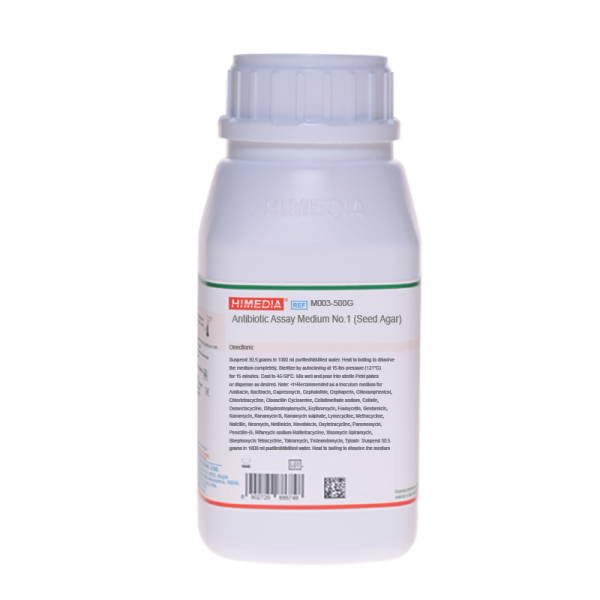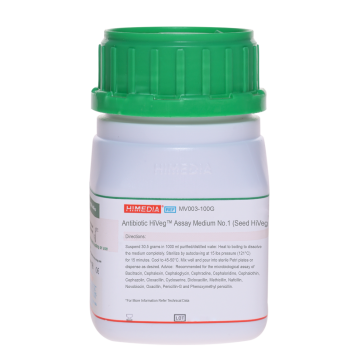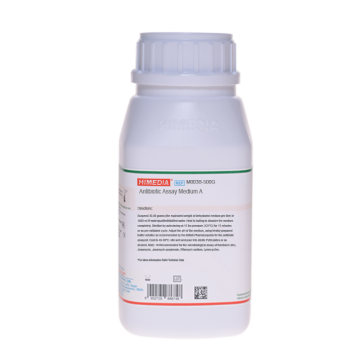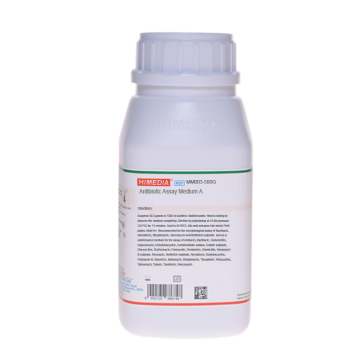 Your enquiry has been submitted
Your enquiry has been submitted
Antibiotic Assay Medium No.1 (Seed Agar)
penicillin/ Inhibitory Substances in Milk#CC293D
Intended use
Antibiotic Assay Medium No.1 (Seed Agar) is used in the microbiological assay of beta-lactam and other antibiotics.
Composition**
| Ingredients | Gms/Litre |
|---|---|
| Peptone | 6.000 |
| Tryptone | 4.000 |
| Yeast extract | 3.000 |
| HM peptone B # | 1.500 |
| Dextrose (Glucose) | 1.000 |
| Agar | 15.000 |
Final pH (at 25°C): 6.6±0.2
**Formula adjusted, standardized to suit performance parameters # Equivalent to Beef extract
Directions
Suspend 30.5 grams in 1000 ml purified/distilled water. Heat to boiling to dissolve the medium completely. Sterilize by autoclaving at 15 lbs pressure (121°C) for 15 minutes. Cool to 45-50°C. Mix well and pour into sterile Petri plates. Advice: Recommended as a inoculum medium for Amikacin, Bacitracin, Capreomycin, Cephalothin, Cephaperin, Chloramphenicol, Chlortetracycline, Cloxacillin, Cycloserine, Colistimethate sodium, Colistin, Demeclocycline, Dihydrostreptomycin, Erythromycin, Framycetin, Gentamicin, Kanamycin, Kanamycin B, Kanamycin sulphate, Lymecycline, Methacycline, Nafcillin, Neomycin, Netilmicin, Novobiocin, Oxytetracycline, Paromomycin, Penicillin-G, Rifamycin sodium, Rolitetracycline, Sisomycin Spiramycin, Streptomycin Tetracycline, Tobramycin, Troleandomycin, Tylosin
Principle And Interpretation
The potency of an antibiotic can be determined by chemical, physical and biological means. An assay is made to determine the ability of an antibiotic to kill or inhibit the growth of living microorganisms. Biological tests offer the most convenient means of performing an assay (1), since a reduction in the antimicrobial activity of a specific antibiotic reveals changes not usually displayed by chemical methods (2). Antibacterial susceptibility testing may be performed by either dilution (turbidimetric) or diffusion methods. The choice of methodology is often based on many factors, including relative ease of performance, flexibility and use of automated or semi-automated devices for both identification and susceptibility testing (3). Grove and Randall have elucidated those antibiotic assays and media in their comprehensive treatise on antibiotic assays (4). Antibiotic Assay Medium No.1 is used in the microbiological assay of B-lactam and other antibiotics. These media are prepared according to the specifications detailed in various pharmacopoeias (2,5,6) and by the FDA (7). Freshly prepared plates should be used for antibiotic assays. Test organisms are inoculated in sterile seed agar cooled to 40-45°C and spread evenly over the surface of solidified base agar. After incubation the concentration of the antibiotic being assayed is determined by measuring the zone of inhibition obtained, with that of reference standard antibiotic. All conditions in the microbiological assay must be carefully controlled. The use of standard culture media in the test is one of the important steps for good results. Nutrients and growth factors are supplied by the ingredients like peptone, Tryptone, yeast extract and HM Peptone B. Dextrose is supplemented as a carbon and energy source.
Type of specimen
Pharmaceutical preparations
Specimen Collection and Handling:
For pharmaceutical samples follow appropriate techniques for handling specimens as per established guidelines (2,5,6). After use, contaminated materials must be sterilized by autoclaving before discarding.
Warning and Precautions :
Read the label before opening the container. Wear protective gloves/protective clothing/eye protection/ face protection. Follow good microbiological lab practices while handling specimens and culture. Standard precautions as per established guidelines should be followed while handling specimens. Safety guidelines may be referred in individual safety data sheets
Limitations :
- Freshly prepared plates must be used or it may result in erroneous results.
Performance and Evaluation
Performance of the medium is expected when used as per the direction on the label within the expiry period when stored at recommended temperature.
Quality Control
Appearance Cream to yellow homogeneous free flowing powder
Gelling Firm,comparable with 1.5% Agar gel
Colour and Clarity of prepared medium Yellow coloured, clear to slightly opalescent gel forms in Petri plates.
Reaction Reaction of 3.05% w/v aqueous solution at 25°C. pH : 6.6±0.2
pH 6.40-6.80
Cultural Response Cultural characteristics observed after an incubation at 35-37°C for 18-24 hours.
| Organism | Inoculum (CFU) | Growth | Recovery | Inoculum medium | Assay medium | Assay medium Inoculum |
|---|---|---|---|---|---|---|
| Bacillus subtilis subsp. spizizenii ATCC 6633 (00003*) | 50-100 | luxuriant | >=70% | Framycetin, Josamycin,Josamycin propionate, Kanamycin B,Spiramycin, Streptomycin, Vancomycin | Streptomycin, Vancomycin | |
| Bordetella bronchiseptica ATCC 4617 | 50-100 | luxuriant | >=50% | Colistimethate sodium,Colistin,Polymyxin B | ||
| Escherichia coli ATCC 10536 | 50-100 | luxuriant | >=70% | Chloramphenicol | ||
| Bacillus cereus var mycoides ATCC 11778 (00001*) | 50-100 | luxuriant | >=70% | Oxytetracycline, Tetracycline | ||
| Bacillus pumilis ATCC 14884 | 50-100 | luxuriant | >=70% | Chlortetracycline,Framycetin, Kanamycin sulphate | ||
| Klebsiella pneumoniae ATCC 10031 | 50-100 | luxuriant | >=70% | Capreomycin,Dihydrostreptomycin, Neomycin,Streptomycin, Troleandomycin | ||
| Micrococcus luteus ATCC 9341 | 50-100 | luxuriant | >=70% | Erythromycin, Erythromycin Rifamycin sodium | Bacitracin | |
| Micrococcus luteus ATCC 10240 | 50-100 | luxuriant | >=70% | |||
| Pseudomonas aeruginosa ATCC 25619 | 50-100 | luxuriant | >=70% | Carbenicillin | ||
| Staphylococcus aureus ATCC 29737 | 50-100 | luxuriant | >=70% | Amikacin, Cephothin, Cephapirin, Chlotetracycline, Cloxacillin, Cycloserine,Demeclocycline, Doxycycline, Kanamycin, Methacycline, Nafcillin, Oxytetracycline, Penicillin-G, Rolitetracycline, Tetracycline, Tobramycin,Tylosin | Cephalothin, Cephapirin,Cloxacillin, Nafcillin,Penicillin-G | |
| Staphylococcus epidermidis ATCC 12228 (00036*) | 50-100 | luxuriant | >=70% | Gentamicin, Neomycin,Netilmicin, Novobiocin, Sisomycin, Paromomycin |
*- Corresponding WDCM numbers
Storage and Shelf Life
Store between 10-30°C in a tightly closed container and use freshly prepared medium. Use before expiry date on the label. On opening, product should be properly stored dry, after tightly capping the bottle in order to prevent lump formation due to the hygroscopic nature of the product. Improper storage of the product may lead to lump formation. Store in dry ventilated area protected from extremes of temperature and sources of ignition Seal the container tightly after use. Product performance is best if used within stated expiry period.
Disposal
User must ensure safe disposal by autoclaving and/or incineration of used or unusable preparations of this product. Follow established laboratory procedures in disposing of infectious materials and material that comes into contact with sample must be decontaminated and disposed of in accordance with current laboratory techniques (8,9).
Reference
- Pelczar M. J. Jr., Reid R. D., Chan E. C. S., 1977, Microbiology, 4th Edi, Tata McGraw-Hill Publishing Company Ltd, New Delhi.
- The United States Pharmacopoeia-National Formulatory (USP-NF), 2022
- Murray P. R., Baron J. H., Pfaller M. A., Jorgensen J. H. and Yolken R. H., (Eds.), 2003, Manual of Clinical Microbiology, 8th Ed., American Society for Microbiology, Washington, D.C.
- Grove and Randall, 1955, Assay Methods of Antibiotics Medical Encyclopedia, Inc. New York.
- The British Pharmacopoeia, 2022, Medicines and Healthcare products Regulatory Agency.
- European Pharmacopoeia, 2022, 10 th volume, European Directorate for the quality of medicines & Healthcare.
- Tests and Methods of Assay of Antibiotics and Antibiotic containing Drugs, .FDA, CFR, 1983 Title 21, Part 436, Subpart D, Washington, D.C.: U.S. Government Printing Office, paragraphs 436, 100-436, 106, p. 242- 259 (April 1).
- Isenberg, H.D. Clinical Microbiology Procedures Handbook 2nd Edition.
- Jorgensen, J.H., Pfaller, M.A., Carroll, K.C., Funke, G., Landry, M.L., Richter, S.S and Warnock., D.W. (2015) Manual of Clinical Microbiology, 11th Edition. Vol. 1.
| Product Name | Antibiotic Assay Medium No.1 (Seed Agar) |
|---|---|
| SKU | M003 |
| Application/ Industry | Pharmaceutical |
| Product Type | Regular |
| Physical Form | Powder |
| Origin | Animal |
| Packaging type | HDPE |
| References | 1. Pelczar M. J. Jr., Reid R. D., Chan E. C. S., 1977, Microbiology, 4th Edi, Tata McGraw-Hill Publishing Company Ltd,New Delhi 2.The United States Pharmacopoeia, 2018, The United States Pharmacopoeial Convention,Rockville, MD. 3.Murray P. R., Baron J. H., Pfaller M. A., Jorgensen J. H. and Yolken R. H., (Eds.), 2003, Manual of Clinical Microbiology,8th Ed., American Society for Microbiology, Washington, D.C. 4.Grove and Randall, 1955, Assay Methods of Antibiotics Medical Encyclopedia, Inc.New York. 5.European Pharmacopoeia, 2017, European Department, for the Quality of Medicines6.British Pharmacopoeia, 2016,The Stationery office British Pharmacopoeia 8.Isenberg, H.D. Clinical Microbiology Procedures Handbook. 2nd Edition. 9.Jorgensen,J.H., Pfaller , M.A., Carroll, K.C., Funke, G., Landry, M.L., Richter, S.S and Warnock., D.W. (2015)Manual of Clinical Microbiology, 11th Edition. Vol. 1. |
| Customized Product Available | No |







